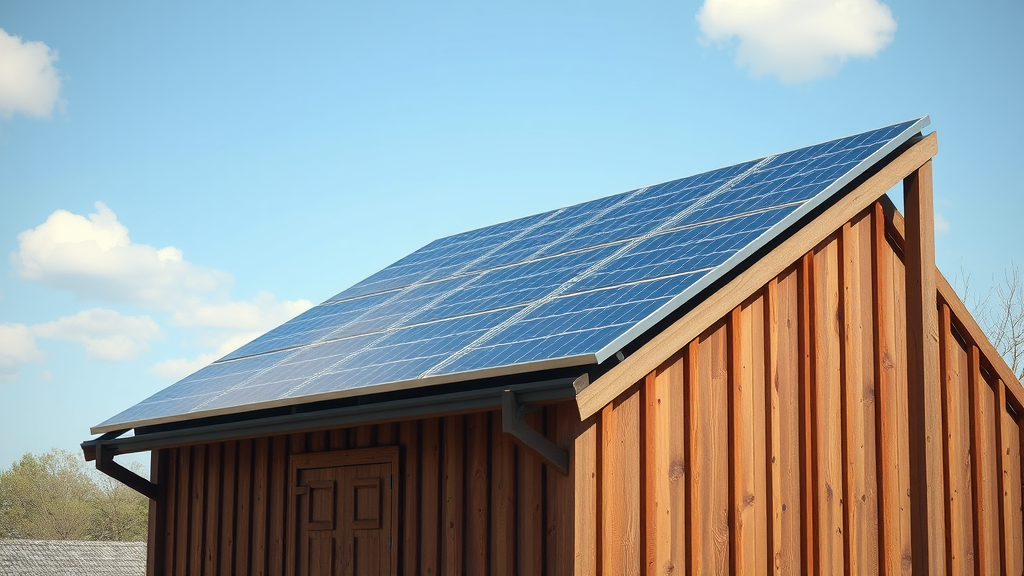Physical Address
304 North Cardinal St.
Dorchester Center, MA 02124
Physical Address
304 North Cardinal St.
Dorchester Center, MA 02124
Explore solar panel for shed with this
comprehensive guide.

Powering your shed with solar energy offers an efficient and environmentally friendly solution for remote or off-grid electrical needs. Modern solar panel systems provide versatile options for shed owners looking to enhance their outdoor workspace or storage area with reliable electricity.
Before investing in a solar panel system, you’ll need to assess your specific power requirements. Calculate the total wattage of devices and equipment you plan to use in your shed. Common applications include:
Multiple solar panel configurations exist for shed applications. Monocrystalline panels offer highest efficiency, typically converting 20-22% of solar energy into electricity. Polycrystalline options provide more budget-friendly alternatives with slightly lower performance rates.
Proper solar panel installation requires careful planning. Optimal placement involves positioning panels to maximize direct sunlight exposure, typically facing south in the Northern Hemisphere. Recommended mounting angles range between 30-45 degrees for maximum energy generation.
Check out one of the top rated solar panel kits here – https://www.healthrefreshed.com/offgrid-solarkits
| Component | Purpose |
|---|---|
| Solar Panels | Energy conversion |
| Charge Controller | Regulates battery charging |
| Inverter | Converts DC to AC power |
| Battery Storage | Stores generated electricity |
Initial solar panel investments range from $500 to $3,000 depending on system complexity. Most residential shed solar systems require 200-400 watts of total panel capacity. Expect approximate payback periods between 3-7 years based on energy usage and local electricity rates.
Complement your solar panel system by implementing energy-efficient practices. Use LED lighting, select low-wattage devices, and consider motion-activated switches to minimize unnecessary power consumption.
For further technical guidance, explore these trusted solar energy websites:
Check out one of the top rated solar panel kits here – https://www.healthrefreshed.com/offgrid-solarkits
U.S. Department of Energy Solar Resources
Solar Electric Supply
Solar Nation Information Portal
By carefully selecting and installing the right solar panel system, shed owners can enjoy reliable, sustainable electricity while reducing long-term energy costs.
Powering your shed with solar energy offers an innovative and sustainable solution for homeowners seeking efficient and eco-friendly electricity options. Solar panel systems for sheds provide remarkable long-term advantages that extend far beyond simple power generation, transforming how we think about peripheral building energy management.
When installing solar panels on shed structures, performance depends on multiple critical factors. Panel orientation, roof angle, and regional sunlight exposure significantly influence overall energy production. Most shed solar systems utilize compact photovoltaic panels ranging from 100 to 400 watts, perfectly suited for smaller electrical needs.
Proactive maintenance ensures your solar panel system operates at peak efficiency. Regular cleaning prevents dust and debris accumulation, which can reduce energy conversion rates. Recommended maintenance practices include:
Check out one of the top rated solar panel kits here – https://www.healthrefreshed.com/offgrid-solarkits
Solar panels for sheds represent a smart financial investment. Over their 25-30 year lifespan, these systems can generate significant electricity savings. Homeowners typically recoup installation costs within 5-7 years, depending on local energy rates and system size.
Implementing solar technology reduces carbon footprint and supports sustainable energy practices. Each kilowatt-hour generated through solar panels prevents approximately 0.85 pounds of carbon dioxide emissions, contributing meaningfully to environmental conservation.
A comprehensive shed solar power system typically includes:
| Component | Function |
|---|---|
| Photovoltaic Panels | Energy conversion from sunlight |
| Charge Controller | Regulates battery charging process |
| Battery Storage | Stores excess generated electricity |
| Inverter | Converts DC to usable AC power |
Modern solar panels are engineered to withstand diverse environmental conditions. High-quality systems resist wind speeds up to 150 mph and maintain functionality in temperatures ranging from -40°F to 185°F. Aluminum frame constructions and tempered glass surfaces provide exceptional durability.
Check out one of the top rated solar panel kits here – https://www.healthrefreshed.com/offgrid-solarkits
While DIY installation is possible, professional solar technicians ensure optimal system configuration. They assess structural integrity, calculate precise electrical requirements, and implement industry-standard mounting techniques.
For additional information, consider exploring these authoritative sources:
Investing in a solar panel system for your shed represents a forward-thinking approach to energy management. By understanding maintenance requirements, technological capabilities, and long-term benefits, homeowners can make informed decisions that simultaneously reduce electricity costs and support environmental sustainability.
Empowering your shed with solar panels represents a smart, sustainable investment that delivers multiple benefits beyond simple electricity generation. By carefully selecting the right solar panel system and maintaining it properly, you can transform an ordinary shed into an efficient, eco-friendly power hub that serves your property’s unique needs.
The journey of implementing solar power for your shed goes far beyond initial installation. Homeowners who invest time in understanding their energy requirements, choosing high-quality panels, and committing to regular maintenance will experience significant long-term advantages. These include reduced electricity costs, increased property value, and a meaningful contribution to environmental conservation.
Check out one of the top rated solar panel kits here – https://www.healthrefreshed.com/offgrid-solarkits
Solar technology continues to evolve, becoming increasingly accessible and affordable. Whether you’re powering workshop tools, maintaining outdoor lighting, or supporting remote communications equipment, solar panels offer a versatile and reliable solution. The initial investment is quickly offset by ongoing energy savings and minimal maintenance requirements.
Ultimately, integrating solar panels into your shed strategy is more than a technical upgrade—it’s a forward-thinking approach to energy management. By embracing renewable technology, you’re not just solving immediate power needs but also positioning yourself at the forefront of sustainable home improvement.
For those ready to take the next step, consulting with professional solar installers can provide personalized insights tailored to your specific shed configuration and energy objectives. With careful planning and the right equipment, your shed can become a model of efficient, green energy utilization.